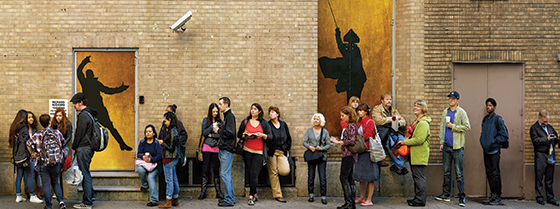 |
For Hamilton rush tickets: A few times a week, a cast member or musical guest sings to the line.
(Photo: Jeff Chien-Hsing Liao) |
Because It Makes Us Feel Like Connoisseurs Among Connoisseurs
Until very recently, people tended to think of the perpetual line as a feature of failed states, where “state” is a catchall term for the social order and its deprivations — think of Depression bread lines, Battle of Britain ration queues, Perestroika tent-city awaiting Moscow’s first McDonald’s. But if you live in a place like New York, you probably now think instead of the ones that snake into Blue Bottle Coffee, or outside sneaker stores to collect shoes that may never be worn, only displayed, or toward a very public audience with Marina Abramovic. These are lines not as deprivation case studies but consumer passion plays. And from the look of things, people seem extremely happy to stand in line (or on line, as New Yorkers so stubbornly say), for almost anything, for almost any amount of time.
These days, the DMV works pretty well, you can hire a TaskRabbit to hold your spot for the Manolo Blahnik sample sale, and there isn’t much you can’t summon from Amazon Prime. But then there are all the lines we’re improbably opting into, since the culture of yuppie abundance that should’ve brought about the end of waiting has actually triggered something like its opposite — a whole new, cultlike fervor for it. Lines are no longer even really a cost to be avoided; they’re an incitement and part of the tribal appeal. What possible other explanation could there be for spending four innings of a Mets playoff game shuffling toward Shake Shack? (Especially when you know, as any fan should, that every other concession stand at Citi Field also serves burgers forged from Pat LaFrieda beef.)
When, early this fall, Chick-fil-A invited customers to camp out in front of what was billed as the chain’s first New York outpost (actually it was the second — there’s another inside an NYU building), it was just the opening gala for what will truly be an unprecedented line-stuffed fall in the city. When Star Wars: The Force Awakens opens in December, it will surely be preceded by days of camping out, and this month, streetwear legend Supreme had to cancel its launch event for its Supreme Jordan 5 because it was so terrified of the inevitable stampede. Dominique Ansel launched his Cronut way back in 2012 — a seminal 18-month period for lines that included the arrival of the “Rain Room,” Mission Chinese, Pok Pok Ny, and Christian Marclay’s The Clock — but every morning the pilgrims are still circling around Spring Street like a noose.
Another way to describe those 18 months is “the life span of the iPhone 5.” Smartphones changed everything about waiting — allowing us to do the only thing we really wanted to do (play on our phones Pavlovishly) while getting credit for the things we think we ought to be doing (accumulating experiences IRL). On the one hand, the new line-lust is just a gullible response to a marketing ploy — introducing scarcity to make people really want something. But, as Pierre Bourdieu could mansplain if you’d pulled him into a movie line, waiting is also an anxious performance of status — signaling that one has an endless amount of time to devote to consumer connoisseurship (invariably of art, food, fashion) while confirming to yourself that you are, in fact, in the right place. At least a right place.
“The act of stepping into line is like putting a stake in the ground: submissive to the people in front of you, dominant to the people behind you,” David Andrews writes in his upcoming book Why Does the Other Line Always Move Faster? — a pretty delicious work of trail-mix pop social science that doesn’t really answer that question but is formatted to fit in a line-waiter’s jacket pocket. Andrews’s view of line culture is playfully paranoid — he sees it as a form of social control, “and if you don’t believe me, recall the sweat that goes into teaching rambunctious kindergartners to pipe down, take turns, and line up already.” But he is sharp on the psychology of it, especially on the way lines turn time into a precious resource (one stockpiled very efficiently by the creative class, which suits Danny Bowien just fine). And then there’s the Zen-surrender (or is it lemminglike?) appeal: “Wouldn’t it be nice to have a switch to turn off the part of our brain not currently needed for the task at hand?” Andrews asks. “As far as social conventions like line-standing go, humans aspire to … the condition of robot.”
As usual, for New York, the robot Warhol got there first: “I like the idea that people in New York now have to wait in line for movies,” he wrote in The Philosophy of Andy Warhol. “The idea for waiting for something makes it more exciting anyway. Never getting in is the most exciting, but after that waiting to get in is the most exciting.”
—By David Wallace-Wells
Some Advice From the City’s Seasoned Queuers
Watch out for German bloggers.
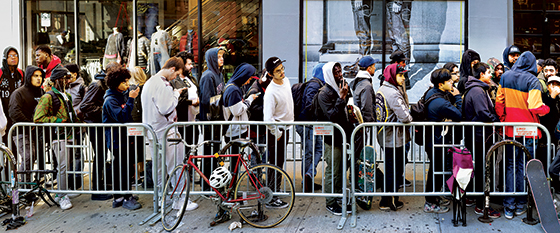 |
For a Supreme release: “I saw a guy almost get punched in the face for cutting.” —Corey Arevalo
(Photo: Jeff Chien-Hsing Liao) |
“It’s important to remind yourself of all the things you learned in kindergarten while you’re standing in line: Cover your cough. Try not to annoy the people around you. Don’t smoke.” —Geri Strugatz, in line for The Late Show With Stephen Colbert.
“When you learn that your flight’s canceled, people usually start lining up to see the flight attendants to get booked on the next flight. Good luck with that. While you’re standing there, use your time to tweet at the airline; most of them have really responsive social media, and they can rebook you much quicker than the people standing there trying to help 100 people standing in front of them all at once.” —Brian Kelly, founder and CEO of the Points Guy, airport expert.
“The only situation in which it’s okay to cut is if it’s something you’re really passionate about and this is your one chance. I cut to the front of a line at a Robert Plant concert because I wanted to get front and center. Other people there, who were maybe in their 50s and 60s, they already had their time. I figured this is my time.” —Natalie Torn, on line for a Grumpy Cat book signing at the Strand.
“Offer to buy the security guard coffee; that way, if I have to go to the bathroom, I can just tell security to save my spot.” —Corey Arevalo, on line at Supreme.
“Be aware of who’s listening to your conversation. On the Apple lines, there are a lot of bloggers. One time I saw this German blogger kind of eyeing me and writing down what I was saying to publish without asking me. When I confronted him about it, his answer was ‘This is America.’ ” —Greg Packer, regular Apple-product waiter.
“If a friend shows up late and joins you in line, just continue talking and act like you’re picking up a conversation where it left off, so people think he or she is just coming back from the bathroom. Be like, ‘So, what did she tell you when you guys broke up?’ ” —Aaron Yazdian, on line for a ramen burger at Smorgasburg.
“A bathroom emergency is the only legitimate excuse to ask someone to hold your place while you leave a line and then come back. For hunger, I think you have to wait.” —Jane Park, on line at Shake Shack.
—Reporting by Trupti Rami, Lauren Schwartzberg, and Erica Schwiegershausen
“I’ve Been Waiting on Line for 39 Years”
“Since 1976, I’ve been going to Russ & Daughters on Sundays for Gaspé and Scottish smoked salmon. Up until 15 years ago, if you got there at 7:55 for the 8 a.m. opening, you’d be first or second. Now you might be 20th. So to be one of the first five, you have to get there at 7:45. Back then, we didn’t form a line. When the doors opened, you just proceeded inside the store in the order in which you arrived. A lot of the young people aren’t as comfortable getting into a conversation. The line has become not unfriendly but not as intimate as it was when it was just regulars. But there wasn’t really ever a hell of a lot of conversation. It’s early in the morning, and people are there for a specific purpose.” —Larry Fuchsman, photographer
—As told to Belle Cushing
How to Pick the Fastest Line
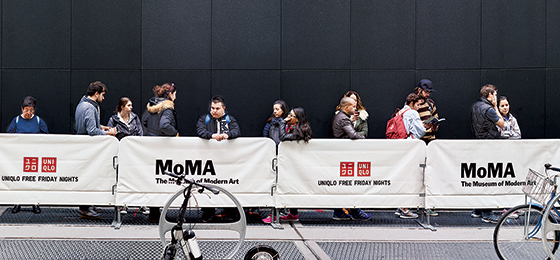 |
For MoMA’s Free Fridays: Best to arrive at 5:30; the line is longest at 3 p.m.
(Photo: Jeff Chien-Hsing Liao) |
Pick a line that’s mostly men. Guys are more easily irritated by long waits than women and are more likely to “be less accepting of their inevitability,” according to researchers at the University of Surrey. It’s possible, then, that men may abandon a line more easily than women, which may bump you up a spot or two.
Veer left. We drive on the right, we tend to pass people walking toward us on the right, and an estimated 90 percent of the world’s population is right-handed. In his new book Math Geek: From Klein Bottles to Chaos Theory, a Guide to the Nerdiest Math Facts, Theorems, and Equations, science writer Raphael Rosen argues that this directional bias leads most of us to naturally head to our right when choosing a line, leaving the left lanes more open. (Hey, it’s worth a try.)
But don’t overthink it. Just pick the line with the fewest people. At the grocery store in particular, the number of people in a line matters more than the number of items in their basket. That’s according to Dan Meyer of the San Francisco math-education start-up Desmos. In 2009, Meyer studied checkout data at his local grocery store and found that each person in line adds at least 41 seconds to your wait time, regardless of how much stuff they’re purchasing. That number accounts for the time it takes the person to say hello to the cashier, pay for the items, gather their stuff, and leave the register. Each item that each person is holding adds an additional 2.8 seconds to your wait. This means, Meyer says, that a line with fewer people in it will move more quickly, even if each person is carrying a lot of stuff.
Ignore the express lane. Again, every additional person takes up much more time than each additional item being purchased, so the express option often doesn’t end up saving much time. If you are waiting behind two people in an express lane and each of you has just five items, it will take three minutes and six seconds for you to get through the line. Compare that to a scenario in which you picked a regular line that also would’ve put two people ahead of you; let’s also say each of you has ten items. According to Meyer’s estimates, you’d be through the line in three minutes and 48 seconds. So the express lane would’ve saved you a whopping 42 seconds, plus it meant you had to buy fewer items. The idea of an “express” checkout is mostly in your head.
Pick a cash-only line if it’s an option. Meyer’s study of his local grocery store found that when people paid in cash, their transactions tended to be quicker than those paying with credit. This was surprising to him, but it makes sense: One credit-card reader can be vastly different from another, causing people to fumble with their cards. Cash, on the other hand, is always the same; we know how to handle that. The slowest method of payment of all, of course, was checks. Don’t pay with a check.
You’re not imagining it. The line you aren’t in really is more likely to move faster. Let’s say you’re in the multiple-line, multiple-cashier scenario, with three lines to choose from. You choose the left lane, but the line to your right seems to be moving faster. Why does this always happen? Hammack explains that this is a simple question of probability. In a three-line setup, you have a one-in-three chance that you have picked the quickest line; meanwhile, there is a two-in-three chance that one of the other two lines will be faster. The odds, unfortunately, are not in your favor (but the advice above can certainly help).
—By Melissa Dahl
7 Things Worth Standing on Line For
And Grimaldi’s is not one of them. (According to our experts.)
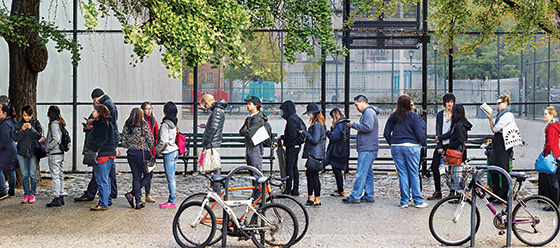 |
For the Cronut: Yes, still.
(Photo: Jeff Chien-Hsing Liao) |
The line: “The Hungarian author Laszlo Krasznahorkai, who was already a growing force in hipster literary circles before he won this year’s Man Booker International Prize, alongside his fan Salman Rushdie at the 92Y on December 14.” —Boris Kachka, contributing editor.
When to stand in it: It’s almost sure to be sold out, so come an hour before the 8 p.m. event and wait in the cancellation line for tickets on a first-come basis.
The line: “Hamilton rush tickets ($10). Plus, the cast has been known to do impromptu performances for the line-waiters.” —Jesse Green, theater critic.
When to stand in it: 2.5 hours prior to the show, when the Ham4Ham lottery is held. The musical performance by a member of the cast of Hamilton or another Broadway guest happens two to three times a week, and for that you just have to get lucky.
The line: “The veggie burger at Superiority Burger.” —Alan Sytsma, food editor, Grub Street.
When to stand in it: 7 p.m. They open at six, and the first half-hour is often people who want to be first in the door; after that, it becomes much more manageable.
The line: “Buzzard Crest stand at the Union Square Greenmarket. Perfectly sweet, intensely aromatic indigenous grapes that will ruin you for supermarket imports.” —Rob Patronite, food editor and critic.
When to stand in it: 8 a.m., right when they open. The line starts forming at 8:15 a.m. and goes until they run out of grapes, which can be as early as 10 a.m.
The line: “Di Fara Pizza. The only pizza line that’s worth it.” —R.P.
When to stand in it: Weekdays at 2 p.m., when most of the initial line — which starts forming at 11:30 a.m. for the noon opening — has been served.
The line: “The day-after-Christmas sale at Saks.” —Diana Tsui, senior market editor, the Cut.
When to stand in it: 7 a.m. (by 7:30 a.m., the line has wrapped around the corner). “When the doors open at 8 a.m., it’s a stampede. The trick is to head straight for eighth floor and hit up the shoes because it tends to be 50 to 60 percent off the lowest marked price.”
The line: “Star Wars: The Force Awakens, which opens on December 18 at AMC Loews Lincoln Square 13, home to the biggest screen in New York.” —Lane Brown, culture editor.
When to stand in it: Anytime that’s not the evening and not between December 24 and December 31, when the schools are on break. And of course, buy your tickets online, never at the box office.
The line: “Top of the Rock at Rockefeller Center, which positions you directly atop the middle of Manhattan, with the city fanning out on all sides. Not the Empire State Building, where the vista doesn’t include the, um, Empire State Building.” —Justin Davidson, architecture critic.
When to stand in it: Anytime before noon; it’s busiest during the sunset hour.
—By Katy Schneider
You Can Also Hire Someone to Stand on Line for You
Waiting for Chick-fil-A with Robert Samuel, founder of Same Ole Line Dudes (sameolelinedudes.com).
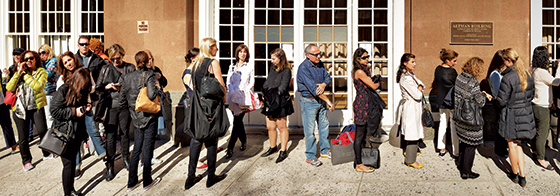 |
For the David Yurman sample sale: Because $1,000 for a silver chain is still better than $2,000.
(Photo: Jeff Chien-Hsing Liao) |
Is now still a good time to talk? Actually, I’m in line at Chick-fil-A. Hey, watch it! [Muffled sounds.] I almost just got run over by a taxi.
You okay? Yeah, I had a lawn chair on me, like a shield. I hit the car right back. Okay, we can talk now. I won’t be inside Chick-fil-A for a minute.
So how did Same Ole Line Dudes start? In 2012, I lost my job at AT&T. When the iPhone 5 came out, I posted an ad on Craigslist to wait for someone’s phone. The customer’s online order ended up going through, so he called me and said, “I don’t need you anymore, but I’ll still pay you the $100.” Then I sold my spot for another $100. I was second in line! I sold a few spots that night and some milk crates for people to sit on. By the time the door opened, I had $325. But it wasn’t until the Cronut that it became a business.
How many jobs do you have per week? I’d say six to eight. I charge $25 for the first hour and $10 each half-hour after that. Two-hour minimum. It’s $5 extra when something falls from the sky. We have 12 to 15 part-time employees, who I just call or text when I need someone.
Are you ever short on line-waiters? A few times, I’ve had to find someone on the street. If one of my people was a no-show or overslept and I have to make a delivery by 9 a.m., I’ll find a neighbor. You’d be surprised; people want to do it. I mean, $25 just for waiting around two hours is a good deal.
Do businesses ever get mad? When the Cronut line first took off, I started selling them on the spot, but Dominique did not like that. I only did that one time.
What’s the hardest line to wait in? Saturday Night Live. They discourage spot holders, so we have to be really careful.
Do you have regulars? One of my best customers, she started out asking for Cronuts. Since then, we waited in the Thanksgiving Day parade for her, I’ve gotten her two iPhones, I’ve gotten her kids toys from GameStop. It’s almost like a best friend that does you favors. Except I charge.
—By Belle Cushing
Or, You Can Cut …
Ethically questionable tactics from 24-year-old producer Lexi T.
“I do not wait in lines. I see a line, and it doesn’t mean anything to me. What’s the worst that’s going to happen? Someone’s like, ‘Oh, excuse me?’ and you apologize? The end.”
Outside a Fashion Week party: “Just walk straight to the front. When there’s a big crowd, no one really knows what’s going on, and if you look like you know what you’re doing, who’s going to question you? It helps that I’m five-foot-two and smiley.”
Outside a club: “I’ve seen people pretend to drop something, bend down and ‘look’ for it, and then, oops, you’re at the front of the line. Tying your shoe also works.”
In a bar: “I’ll start by assessing where I can break in. I usually like to go about five people from the front because they’re less aware of who’s in front and behind them. It’s also good to target people who are talking, because they normally won’t notice. So I’ll stand near the spot I want to break into, and when the line starts moving, I’ll slot right into the open space.”
At Pret à Manger: “There are usually so many people not paying attention, so I just take the initiative to go to the front and the line will start forming behind me.”
For the bathroom: “Sometimes I’ll go to the men’s room.”
—By Lauren Schwartzberg
What New Yorkers Have Other People Wait For
According to TaskRabbit, from most to least frequently: concerts at Mercury Lounge, shows at Upright Citizens Brigade Theatre, Cronuts at Dominique Ansel Bakery, a seat at Mission Chinese Food, beer releases at Other Half Brewing Company, a seat at El Sabroso, shows at Radio City Music Hall, events at Brooklyn Bowl, tickets to The Daily Show, an appointment at the New York Passport Agency, products at the Apple store, cupcakes at Magnolia Bakery, burgers at Shake Shack, a spot to watch the Macy’s Thanksgiving Day Parade, sneakers at the Nike store.
Line-Improvement Theories
1. There is a better way to board an airplane. According to astrophysicist Jason Steffen, boarding should ideally start from the back of the plane but be staggered by every-other row and by seat type. In an experiment, the Steffen method was twice as fast as the standard back-to-front model and up to 30 percent faster than random boarding.
2. The last shall be first. Two Danish researchers compared a typical line to two other methods: In one, people were helped in a random order. In the other, those last in line were served first. As it turned out, the last-come-first-served method got the most people where they needed to go quickest.
3. Just give the people wine. Richard Larson, an MIT professor and queuing expert, has a simple solution for making lines more bearable: “Does anything replace a restaurateur who gives guests a free glass of wine as they peruse the menu while waiting? And, double benefit for the restaurateur, the table time of the party is reduced, because they no longer spend table time figuring out what to order. Everyone is happy.”
On Getting a Global Entry Interview
How to avoid the line for avoiding the Customs line at the airport.
1. The online interview-appointment system works a bit like reservations at Momofuku Ko: They are canceled and re-reserved all the time. When you log in, the next available date is usually months away. Take whatever they have, but keep refreshing throughout the day and you can often find one for that week.
2. Because most interviews take place at airports, many travelers plan their appointments during layovers or after scheduled landings. But since plane delays are commonplace, those interviews frequently get missed. So if you have Wi-Fi on your plane, you might be able to snag a slot for the time you land. Others have reported success just walking in.
3. Some locations get more backlogged than others. While Boston-Logan and Newark-Liberty might have extra-long wait times, Albuquerque and Anchorage do not. Going home to New Mexico for Christmas? Book your excuse to get out of that awkward immigration discussion with Uncle John.
—By Nicholas Gill